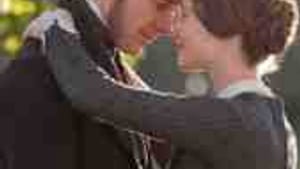Stay in the Loop
BSR publishes on a weekly schedule, with an email newsletter every Wednesday and Thursday morning. There’s no paywall, and subscribing is always free.
Jane Eyre's coming-out party
Cary Fukunaga's "Jane Eyre' on film (2nd review)

"I can't believe how many times we've watched this movie," my husband said as we arrived at the theater.
"Not this version!" a female friend and I burst out in perfect unison.
Our DVD player hosts a steady stream of Jane Eyres. Several weeks before the premiere of the latest version, directed by Cary Fukunaga and starring Mia Wasikowska, we missed the beginning of Johnny Depp as Rango because I had to stop and read the entirety of a Jane Eyre review printed on a theater display.
Never had a movie outing been so assiduously planned among so many parties as the latest Jane Eyre was among my girlfriends.
"What are you hoping for with this Jane Eyre?" I asked my friend.
"Probably Colin Firth," her boyfriend answered.
"He's in Pride and Prejudice," we said.
"Whatever. Same author, right?"
Since my husband had been gracious enough to accompany six women to yet another version of the film he calls "the one with the crazy wife," we let it go. But it's true that people rarely comment on Jane Eyre without invoking Jane Austen as well. Perhaps it's the relative scarcity of famous 19th-century female novelists, or perhaps it's because we all read Charlotte Brontë and Austen in the same year of high school.
This heroine doesn't change
My own musings on the Austen/Brontë roundup began with an essay by Alfred MacAdam in a 2005 edition of Austen's Northanger Abbey. Given that book's gothic satire, MacAdam contrasts "romance" works with "true novels" like Austen's.
"Catherine must change… become, by the end of her story, another person," MacAdam writes of Northanger's over-imaginative protagonist. "This is exactly what romance characters cannot do. They are what they are from start to finish."
It's an insuperable difference between the Austen heroines and Jane Eyre. The main point of Emma, Pride and Prejudice and the rest is the evolution of the protagonist's character and opinions. The spine of Jane Eyre, by contrast, is her steadfastness in all circumstances: her absolute loyalty to single moral view. She speaks in the same forthright, unbending voice as a child as she does through all her adult trials.
One innovation
But Moira Buffini's new screenplay contains at least one interesting departure from Brontë's novel (and from most film adaptations) that might merit a comparison between this Jane Eyre and her more changeable Austen counterparts. After Mr. Rochester proposes to his ward's "Quakerish" governess, Brontë makes a meal of Jane's insistence that the dazzlingly rich Rochester buy her only the plainest goods. Upon his insistence that she will wear jewels, satin and priceless lace, Jane -- poor, obscure, plain and little -- says such clothes would make her "an ape in a harlequin's jacket."
But in this film, Jane fingers her wedding lace and silken flowers in awe. "I will be Jane Eyre no longer," she marvels. The implication is that our newest Jane's character is a bit more subject to her circumstances -- until tragic secrets loom.
Fukunaga's Jane Eyre embraces the Gothic chills that blanket the original story. Candles flicker, the wind howls, and mysterious drafts stir the curtains. The film's starkly beautiful houses convey a profound, sweeping isolation -- the characters almost seem to be driven outdoors by their loneliness, where they meet in the mist and the wind for the most pivotal scenes.
Jane's physical world
Buffini retains much of the original's ornate language ("I was solitary and despised," the childhood Jane intones), while the film revels in Jane's physical world like no other: You feel the sodden weight of a cloak in the rain, the squelch of shoes on the moor, the sharp brutality of young Jane's abusers, and the light of the fire.
As Jane, Wasikowska's ethereal complexion is like a part of the twilight or chilly dawn that bathes her in nearly every scene. Judi Dench as Thornfield's housekeeper and Tamzin Merchant (of The Tudors) as Mary Rivers add interest to often-generic roles. Jamie Bell as the clergyman St. John Rivers keeps the cold-hearted edge that some adaptations gloss over.
Girls vs. guys
Girls like me flock to every Jane Eyre film adaptation with the kind of consistency you can expect in Jane herself. The opposite male response may be just as predictable. At the very moment Jane leaned in to kiss Rochester for the first time, my husband elbowed me.
"Ha, look at that guy," he said, pointing to a solitary moviegoer two rows away. "He came to Jane Eyre by himself!"
But the magic of Jane Eyre wasn't totally lost on the men. Afterwards, a boyfriend said that it wasn't as bad as he thought it was going to be. "I didn't fall asleep," he admitted to all present.
As St. John Rivers urged Jane to become his missionary wife and scolded her refusal as "unfeminine and untrue," my husband nudged me again.
"That was the lamest proposal I've ever heard," he whispered. "That guy didn't say anything about love."
Jane Eyre would be proud of him. Almost four years into our marriage, and nearing a decade in our relationship, he's kept his own steadfast sense of romance.
♦
To read another review by Madeline Schaefer, click here.
"Not this version!" a female friend and I burst out in perfect unison.
Our DVD player hosts a steady stream of Jane Eyres. Several weeks before the premiere of the latest version, directed by Cary Fukunaga and starring Mia Wasikowska, we missed the beginning of Johnny Depp as Rango because I had to stop and read the entirety of a Jane Eyre review printed on a theater display.
Never had a movie outing been so assiduously planned among so many parties as the latest Jane Eyre was among my girlfriends.
"What are you hoping for with this Jane Eyre?" I asked my friend.
"Probably Colin Firth," her boyfriend answered.
"He's in Pride and Prejudice," we said.
"Whatever. Same author, right?"
Since my husband had been gracious enough to accompany six women to yet another version of the film he calls "the one with the crazy wife," we let it go. But it's true that people rarely comment on Jane Eyre without invoking Jane Austen as well. Perhaps it's the relative scarcity of famous 19th-century female novelists, or perhaps it's because we all read Charlotte Brontë and Austen in the same year of high school.
This heroine doesn't change
My own musings on the Austen/Brontë roundup began with an essay by Alfred MacAdam in a 2005 edition of Austen's Northanger Abbey. Given that book's gothic satire, MacAdam contrasts "romance" works with "true novels" like Austen's.
"Catherine must change… become, by the end of her story, another person," MacAdam writes of Northanger's over-imaginative protagonist. "This is exactly what romance characters cannot do. They are what they are from start to finish."
It's an insuperable difference between the Austen heroines and Jane Eyre. The main point of Emma, Pride and Prejudice and the rest is the evolution of the protagonist's character and opinions. The spine of Jane Eyre, by contrast, is her steadfastness in all circumstances: her absolute loyalty to single moral view. She speaks in the same forthright, unbending voice as a child as she does through all her adult trials.
One innovation
But Moira Buffini's new screenplay contains at least one interesting departure from Brontë's novel (and from most film adaptations) that might merit a comparison between this Jane Eyre and her more changeable Austen counterparts. After Mr. Rochester proposes to his ward's "Quakerish" governess, Brontë makes a meal of Jane's insistence that the dazzlingly rich Rochester buy her only the plainest goods. Upon his insistence that she will wear jewels, satin and priceless lace, Jane -- poor, obscure, plain and little -- says such clothes would make her "an ape in a harlequin's jacket."
But in this film, Jane fingers her wedding lace and silken flowers in awe. "I will be Jane Eyre no longer," she marvels. The implication is that our newest Jane's character is a bit more subject to her circumstances -- until tragic secrets loom.
Fukunaga's Jane Eyre embraces the Gothic chills that blanket the original story. Candles flicker, the wind howls, and mysterious drafts stir the curtains. The film's starkly beautiful houses convey a profound, sweeping isolation -- the characters almost seem to be driven outdoors by their loneliness, where they meet in the mist and the wind for the most pivotal scenes.
Jane's physical world
Buffini retains much of the original's ornate language ("I was solitary and despised," the childhood Jane intones), while the film revels in Jane's physical world like no other: You feel the sodden weight of a cloak in the rain, the squelch of shoes on the moor, the sharp brutality of young Jane's abusers, and the light of the fire.
As Jane, Wasikowska's ethereal complexion is like a part of the twilight or chilly dawn that bathes her in nearly every scene. Judi Dench as Thornfield's housekeeper and Tamzin Merchant (of The Tudors) as Mary Rivers add interest to often-generic roles. Jamie Bell as the clergyman St. John Rivers keeps the cold-hearted edge that some adaptations gloss over.
Girls vs. guys
Girls like me flock to every Jane Eyre film adaptation with the kind of consistency you can expect in Jane herself. The opposite male response may be just as predictable. At the very moment Jane leaned in to kiss Rochester for the first time, my husband elbowed me.
"Ha, look at that guy," he said, pointing to a solitary moviegoer two rows away. "He came to Jane Eyre by himself!"
But the magic of Jane Eyre wasn't totally lost on the men. Afterwards, a boyfriend said that it wasn't as bad as he thought it was going to be. "I didn't fall asleep," he admitted to all present.
As St. John Rivers urged Jane to become his missionary wife and scolded her refusal as "unfeminine and untrue," my husband nudged me again.
"That was the lamest proposal I've ever heard," he whispered. "That guy didn't say anything about love."
Jane Eyre would be proud of him. Almost four years into our marriage, and nearing a decade in our relationship, he's kept his own steadfast sense of romance.
♦
To read another review by Madeline Schaefer, click here.
What, When, Where
Jane Eyre. A film directed by Cary Fukunaga, based on the novel by Charlotte BrontÓ«. For Philadelphia-area show times, click here.
Sign up for our newsletter
All of the week's new articles, all in one place. Sign up for the free weekly BSR newsletters, and don't miss a conversation.

 Alaina Johns
Alaina Johns